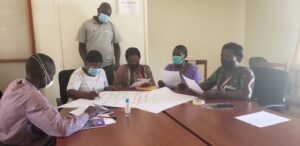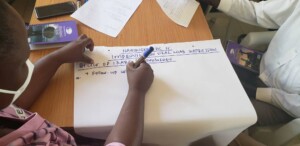Tackling gender, youth, and social inclusion gaps to improve viral load suppression among men and children in Tororo district
By Elizabeth Kemigisha, WI-HER’s Technical Specialist, Collaboration, Learning and Adaptation
Summary: This story highlights how identifying and tackling gender, youth, and social inclusion issues with community and facility influencers can impact viral load suppression among HIV clients who are not suppressing even when they are active in care. It draws from Nagongera Health Centre IV and Mulanda Health Centre IV experiences in Tororo district in Eastern Uganda. The project’s vision is committed to progressing USAID/Uganda’s Journey to Self-Reliance (J2SR) and the CDCS 2016-2021, which seeks to improve the adoption of priority behaviors at the individual, household, and community levels. The story connects to development objective 1, which aims to increase community and household resilience in select areas and target populations, i.e., applying iDARE methodology, a community-driven approach. Additionally, the story further links to sub immediate results 1.3, which calls for enhanced prevention and treatment of HIV, malaria, and other epidemics among the most vulnerable. This story highlights how the project tackles gender issues affecting men and children to increase treatment outcomes.
“Prior to applying the iDARE methodology, our numbers for unsuppressed clients were big, we didn’t look at them through the gender lens for example breaking them down by their gender and age and further tackling each. Conversations with men improve the adherence and viral load suppression of the entire family” – Apoya Christine Data Assistant, Mulanda HCIV

WI-HER, through the USAID/Social and Behavior Change Activity, is supporting Tororo district Local Government (DLG) and the USAID-funded initiative, the Regional Health Integration to Enhance Services in Eastern Uganda (RHITES-East) activity, to implement community social behavior change interventions using WI-HER’s iDARE (Identity, Design, Apply/Assess, Record, Expand) methodology in Tororo district in the facilities Nangongera HCIV and Mulanda HCIV. iDARE is an innovative results-oriented methodology grounded in improvement science, social behavior change theory, and human-centered design that ensures solutions address gender youth and social inclusion (GYSI) issues and are community-owned, sustainably delivered, responsibly managed, and adequately documented.
IDENTIFY: Using DHIS2 data, WI-HER supported USAID RHITES-East and Tororo DLG to identify challenges with HIV viral load suppression rates among men and children as one of the major issues requiring intervention. A review of baseline data at Nagongera HC IV indicated that 65% of men and 60% of children were virally suppressed of those actively in care compared to 92% of women. Therefore, the project zeroed down to supporting HIV treatment outcomes using the iDARE methodology. Specific emphasis was put on addressing GYSI barriers impacting retention and adherence behaviors in this first selected testing site.
“Patients come from the community and go back to the community. The methodology strengthens the community’s role in patient care” – Lamu Edet TB focal person, Tororo district local government.
DESIGN: To support the facility and community to sustainably address the low viral load suppression rates among men and children, the first cohort of 16 children and 14 men (enrolled in HIV treatment and care but not virally suppressed) was selected to receive support using the iDARE methodology. A small number of men and children were selected to allow the facility and respective iDARE team members to gain confidence and understanding of utilizing the iDARE methodology. iDARE entails recruiting influencers from the community and facility to propose and implement local solutions to support clients in changing their behaviors and testing ideas. The cohort (and caretakers of children) were interviewed to understand the GYSI issues impacting their behavior and their most prominent influencers. An iDARE team was formed following the identification of influencers with help from the cohort, and created to understand the GYSI issues impacting the cohort’s health outcomes; identify gaps; and design and test solutions among these selected clients.
APPLY AND ASSESS: The iDARE team tested these solutions to improve behaviors to achieve viral load suppression of the cohort and continuously brainstorm additional solutions to gain a deeper understanding of the cohort and GYSI issues impacting behavior. For non-suppressed men, one of the GYSI issues identified was that they send wives to the facility on their behalf for their appointments to collect medication. The successfully tested solution was to have the community linkage facilitators (an established influencer) speak to the men about positive attitudes to access care at the right time and follow up with the men at the facility for their appointments to support them and feel more comfortable going to the facility themselves when non-suppressed clinics were set up on Tuesdays. Another GYSI issue identified was that the non-suppressed children stayed with the elderly (i.e., grandparents) who could not support them efficiently in appointment keeping and treatment adherence. The successfully tested solution was that an influencer (community linkage facilitator or pastor) takes the medication to the child at home or conducts home visits. When there is a need for transport, the pastor organizes transport to the facility for their appointments through community mobilization.
 During a learning session conducted in Tororo district in March 2021 between Nagongera HCIV and Mulanda Teams iDARE teams, Christine Apoya, the Mulanda HCIV data assistant, noted that applying iDARE has enabled them to have all the data at their fingertips because they are constantly looking at it to support the cohorts adequately. Both iDARE teams highlighted GYSI issues that affect viral load suppression during the community visits, including domestic violence among discordant couples, especially for women; child neglect; and side effects of HIV treatment among children. Among the tested, successful solutions included forming peer groups for children and engaging partners in spousal support. Within the facilities, the iDARE teams championed some structural changes like creating non-suppression clinics where the non-suppressed are encouraged by the suppressed clients, health education talks are conducted every morning for the various clinics on scheduled topics, and weekly staff meetings are conducted to strengthen data to action.
During a learning session conducted in Tororo district in March 2021 between Nagongera HCIV and Mulanda Teams iDARE teams, Christine Apoya, the Mulanda HCIV data assistant, noted that applying iDARE has enabled them to have all the data at their fingertips because they are constantly looking at it to support the cohorts adequately. Both iDARE teams highlighted GYSI issues that affect viral load suppression during the community visits, including domestic violence among discordant couples, especially for women; child neglect; and side effects of HIV treatment among children. Among the tested, successful solutions included forming peer groups for children and engaging partners in spousal support. Within the facilities, the iDARE teams championed some structural changes like creating non-suppression clinics where the non-suppressed are encouraged by the suppressed clients, health education talks are conducted every morning for the various clinics on scheduled topics, and weekly staff meetings are conducted to strengthen data to action.
“There are other stakeholders in the community who know the needs of the people and can help with the mobilization further adding value to the facilities, like pastors, teachers, and other members of the community.” – Aciya Michel – Community Educator
RECORD: To date, there is rapid progress achieved in viral load suppression among the cohort. From the tested solutions in Nagongera HC IV, follow-up data collected showed a steady increase in viral load suppression rates among a purposely selected non-suppressed cohort of 14 men and 16 children from 0% in August 2020 to 73% in December 2020, with 100% suppression by February 2021. By October, the iDARE team already began expanding solutions to address GYSI issues for men and children beyond the cohort. The iDARE team increased the total suppressed men from 357 (60%) to 461 (84%) out of the 550 men active in care and 62 (60%) to 84 (82%) children suppressed out of the 103 children active in care at Nagongera HCIV by February 2021. Throughout this process, the team continuously documents newly identified GYSI issues and tested solutions. Initial learnings and a test package of behavior change interventions drawn from the initial two learning sites will be put to scale in the 16 identified USAID/Social and Behavior Change Activity learning sites in various health areas.
EXPAND: To ensure the sustainability of the intervention, WI-HER has prioritized building RHITES-East’s capacity to conduct regular coaching sessions at the testing sites. Coaching involves reviewing progress in behavior change, documentation in the iDARE facility journal, and organizing capacity-building sessions. Through these coaching sessions, the nursing officer (iDARE team lead) from Nagongera HC1V was identified as an iDARE champion, and she went on to support USAID/SBCA, RHITES-E, and other implementing partners in the scale-up process to Mulanda HCIV and learning districts, Kapchorwa and Kaberamaido.
USAID Social and Behavior Change Activity is made possible by the support of the American people through the United States Agency for International Development (USAID) and is implemented by Johns Hopkins Center for Communication Programs (CCP) in partnership with The Medical Concierge Group (TMCG), The Busara Center for Behavioral Economics, Women Influencing Health, Education and the Rule of Law (WI-HER), and World Vision Inc.